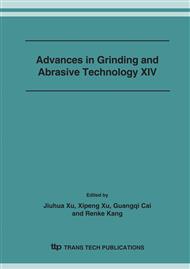p.389
p.394
p.399
p.404
p.409
p.414
p.420
p.425
p.431
Fabrication of WC-6Co-1.5Al (wt%) Hardmetal by High Energy Milling and Electrical Current Sintering
Abstract:
Ultrafine grain WC hardmetals were manufactured successfully from mixed powders of nominal composition of WC-6Co-1.5Al(wt%). To manufacture bulk ultrafine grain WC alloys, nanocrystalline WC powders as precursor were prepared for sintering from the mixed commercially available powders by high energy milling of 15 h. Then the electrical current sintering process of the milled powders was further studied. Experimental results showed that the density, hardness and transverse rupture strength of the sintered alloys reached 14.224 g/cm3, HRA 94 and 1660 MPa, respectively, by a appropriate coupling of pulse- and subsequent constant-current sintering and with the total sintering time of 6 min. It seemed difficult to obtain desirable sintered hardmetal by a single type of electric current sintering. However, the application of intensive pulse electric current was favorable to sintering, although it was difficult to achieve good WC alloys only by the pulse electric current sintering. A higher density WC alloy could be prepared by enlarging the electric current when only constant electric current was applied to sinter the milled powders. Unfortunately, the WC grains substantially coarsened concurrently so that the mechanical properties of the as sintered alloy decreased obviously.
Info:
Periodical:
Pages:
409-413
Citation:
Online since:
November 2007
Authors:
Price:
Сopyright:
© 2008 Trans Tech Publications Ltd. All Rights Reserved
Share:
Citation:


